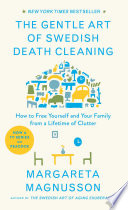Margareta Magnusson’s first book in a two-book series, “The Gentle Art of Swedish Death Cleaning: How to Free Yourself and Your Family from a Lifetime of Clutter,” recounts the three times in her life that she had to organize the belongings of a dearly departed loved one and how she did it. It is a brilliant bit of marketing because the title evokes a long-standing tradition instead of an author’s idea and fulfillment of a dream to write a book. If the tradition predates the author, my apologies, but I did not glean that information from the book.
If you are looking for a Marie Kondo type book, this book may not be for you, but if you don’t mind heavy doses of memoir with your self-help books, then this book may be for you.
As a lawyer, I took great delight in making my will so I was attracted to “The Gentle Art of Swedish Death Cleaning” because I wanted to bring that energy into my daily life, especially since I hate cleaning. I also liked the irrational idea that döstädning could lead to more humanistic policies, which Magnusson sneaks in with urging people to consume lesson, reuse and recycle, for the health of the environment. While I do not regret reading the book, it did not meet my expectations. After reading it, most of the principles evaporated, and I took an anthropological approach to the book.
“The Gentle Art of Swedish Death Cleaning” provides insighs regarding how a well-traveled octogenarian-plus woman navigates an ever-changing world. Her insights into gender norms were fascinating as she embraced and disapproved of them. I am unfamiliar with Magnusson, who is an artist and author and a wife and mother. While she accepted that she had to take care of the döstädning for her mother-in-law, she lobs some passive aggressive shots at the men of her generation for feigning helplessness in this area and applauds younger generations of men for being less allergic than her contemporaries.
While Magnusson’s writing style is approachable, her experience may not be relatable precisely because she is Swedish. How many readers must consider how to dispose of the family’s boats? Americans will clutch their pearls when she addresses how she handles moving to different countries without being able to bring her animal companions. She wears a wok on her head and becomes the toast of a party. Just her ability to travel, retire and not worry about money or time as she downsizes could alienate readers and make them ditch the book as inapplicable to their struggles. I do not think that most Americans will be able to push past the stories and draw out universal principles without stopping and comparing our lives with hers and find ours wanting. While “The Gentle Art of Swedish Death Cleaning” scoffs at the cost of paying for certain services instead of doing it yourself, Magnusson does not verbalize horror at the increasing cost of living such as property costs. Her concerns are about living a satisfying life, not surviving. Maybe abundance is a common characteristic of books that focus on downsizing, but the fortunate do not have a monopoly on clutter. It does provide a window into a Swedish’s person’s experience.
On a personal level, “The Gentle Art of Swedish Death Cleaning” gets awkward when she gets passive aggressive and drops hints to her loved ones regarding how she would like them to act. While most of her tips get accompanied with a personal story behind the object, these stories take a left turn when she has rare moments of disapproval. For example, when she advises on how to organize and dispose of correspondence, she includes a subtle jab that her children and grandchildren do not send thank you cards. One less thing to worry about! She chides her contemporaries for refusing to engage with the Internet and missing out on a lot of cool things like streaming television and movies. Agreed!
The key to “The Gentle Art of Swedish Death Cleaning” is to start with the literal big stuff then work your way down. After you have assessed what you do not want, keep, regift or give away what remains. While she suggests selling, I have yet to see a book that gives practical tips on the best way to approach what is another full-time job. It is probably because selling is a region-specific activity unless the shipping costs and packaging are worth the effort.
If döstädning sounds morbid, “The Gentle Art of Swedish Death Cleaning” is the opposite. While Magnusson discusses the loss of family and preparing for one’s eventual demise, so you do not leave a burdensome task to those who survive us, loved ones or not, Magnusson’s tone is as light and airy as a souffle. She sees the act as a way of living a more comfortable life and sees it as an opportunity to relive favorite memories such as skiing in a bikini, which she kept. If you fear death, this book may be a good way to ease into getting over your fear of mortality and just view it from a practical lens.
Even though “The Gentle Art of Swedish Death Cleaning” is a short book that you could probably read in one sitting, I dragged it out because I just was not into it. Instead of taking notes on how live a full life and be an elderly person filled with joy instead of disillusionment, I found very little that I could remember after turning the pages. Blame my personality instead of the author, but if you like my personality, then this book probably is not what you are into.




